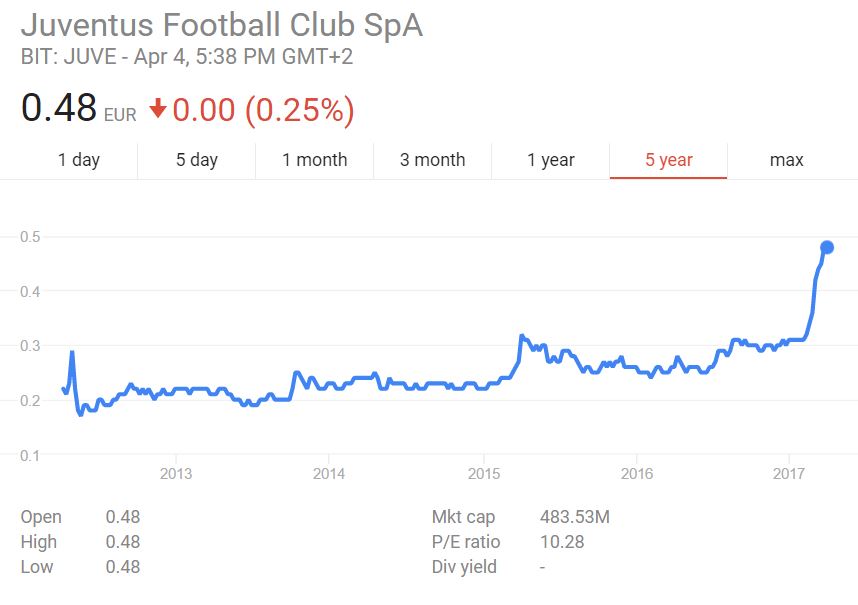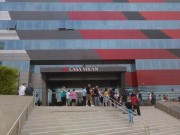What is behind Juventus’ stock rally? This is the question that a lot of investors are discussing regarding the latest performance of Juventus in the stock market. Since the beginning of the year, Juventus’ share price has surged by almost 70%, from €0,20 to €0.49, as well as a huge increase in traded volumes in the last weeks.
A simple answer to this question would be to tie this increasing investors’ interest as a result of the Juventus’ management ability led by President Andrea Agnelli to combine “on the pitch” success with healthy financial statements.
In soccer teams, revenue streams come mostly from transfer market deals and multi-year commercial contracts (sponsorships and TV rights for example) which, at least in the short term, are not entirely dependant on sport results (which, however, influence a lot more long term revenue projections). As a result, it was possible to forecast already at the beginning of the season a profitable quarter for Juventus.

The consistent capital gains generated from the sale of Pogba and Morata, and the guarantee to participate in UCL sharing the TV rights incomes only with Napoli (given the elimination of Roma at preliminary) were items on the table since September.
Since then, only a few things have impacted the big picture. Napoli elimination in UCL which will allow Juventus to earn a few millions more due to the redistribution of the market pool Uefa.

The qualification of Juventus to the next round, which besides the performance bonus paid out by Uefa, will make Juventus’ stadium revenue increase by at least €3 million thanks to the “sold out” for Juventus-Barcelona at Juventus Stadium, does not seem to be enough to justify the stock market euphoria around the club in the last weeks.
Other elements would suggest that Juventus’ positive strike won’t be coming to an end anytime soon. Firstly, Juventus is almost certain to participate in Champions League next season as well. Secondly, thanks to the new format of UCL which from 2018/19 will allow four Italian teams to be directly qualified to the group stage, there is a good chance that we will see Juventus in Champions League in the coming years. This will allow Juventus management to plan for next years counting on the consistent prize money distributed by Uefa.
Inter & AC Milan effect on Juventus
Is this all to explain Juventus’ stock rally? Let’s take a look at the major competitors of the club. In the transaction for the acquisition of 68% of Inter by Chinese’s king of electronics, the club’s equity valuation was set at €650 million considering revenue for €202 million in 2015/16. Inter’s valuation is 3.2x its revenue.

Yonghong Li acquisition price for 99% of AC Milan is €520 million, given €216 million in revenue for 2015 (last available statement). This indicated a valuation of 2.4x its revenue.

Juventus, instead has a market capitalization of €485 million with €341 million in revenue as of 2015/16. This means a 1.4 multiplier, which is considerably lower than its historical rivals in Italy. As a result, it could be possible that the stock market is aligning Juventus’ share price towards the valuation given to the Milan’s clubs by the Chinese investors.
Speculative suggestions
There is also a speculative reason linked to the Exor group. The holding, owner of Juventus among FCA, Ferrari, and CNH, moved its headquarters in the Netherlands. This strategic fiscal move allows Exor not to pay taxes on capital gains for the sale of assets, and also to reorganize the voting rights based on shareholding seniority.
This means that in 10 years, the Elkann-Agnelli family that currently holds 51% of Exor’s shares, will be able to nominate the board of advisors even with only 5% of the shares.
For this reason, if Exor were to consider in selling part of Juventus to a strategic partner but still remaining the reference shareholder, the next few months might probably be the best time to capitalize on it.
With the sale transactions of Inter (already concluded) and AC Milan (closing pending) that benchmarked the market, a share of Juventus could be sold for even more than what the current market value is. This last one, even if intriguing, stays for now merely an academic hypothesis.







































